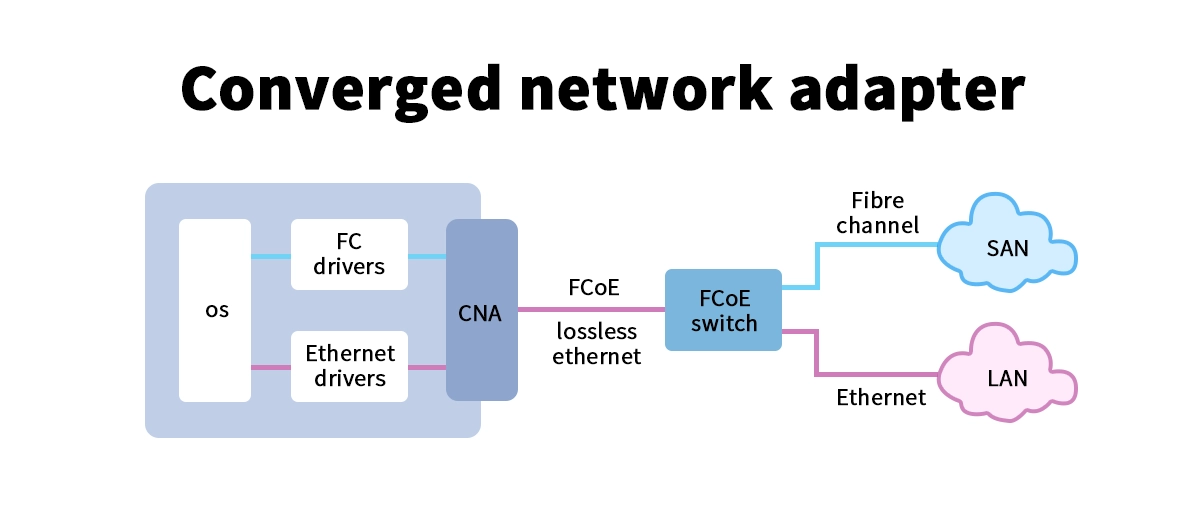
In today's fast-paced digital world, businesses are constantly seeking ways to streamline their IT infrastructure, reduce costs, and boost performance. One technology that stands out in this quest is the Converged Network Adapter (CNA). But what exactly is a CNA, and why should you care? In this comprehensive guide, we'll dive deep into the world of converged network adapters, exploring their functionality, benefits, and how they can transform your network architecture. Whether you're an IT professional or a tech enthusiast, you'll gain valuable insights into this powerful tool—and even discover how brands like LINK-PP are driving innovation in this space. Let's get started!
⚡ Introduction to Converged Network Adapters
A Converged Network Adapter (CNA) is a specialized hardware component that combines the functions of a traditional network interface card (NIC) and a host bus adapter (HBA) into a single device. By integrating data networking (e.g., Ethernet) and storage networking (e.g., Fibre Channel) over a unified fabric, CNAs enable organizations to consolidate their infrastructure, leading to reduced complexity, lower costs, and enhanced scalability. This convergence is particularly relevant in virtualized environments and data centers, where efficiency is paramount.
But why is this important? Imagine running separate networks for storage and data—it's like having two highways side-by-side with no intersections. CNAs merge these into one superhighway, allowing traffic to flow seamlessly. As more businesses adopt cloud computing and big data analytics, understanding CNAs becomes crucial for optimizing network performance. Plus, with the rise of high-speed technologies, integrating components like optical modules from trusted providers such as LINK-PP can take your setup to the next level.
⚡ How Does a Converged Network Adapter Work?
At its core, a CNA leverages protocols like Fibre Channel over Ethernet (FCoE) to transmit both storage and data traffic over a single Ethernet cable. This eliminates the need for separate adapters and switches, simplifying the network topology. Here's a simplified breakdown:
Protocol Convergence: CNAs use FCoE to encapsulate Fibre Channel frames within Ethernet packets. This allows legacy storage systems to communicate over standard Ethernet networks without modification.
Hardware Offloading: By handling processing tasks on the adapter itself, CNAs reduce CPU overhead on servers, improving overall system performance. This is especially beneficial for resource-intensive applications.
Unified Management: With a CNA, IT teams can manage networking and storage through a single interface, reducing administrative burdens and minimizing errors.
In practice, a CNA connects to a converged switch, which directs traffic appropriately—storage data to SANs (Storage Area Networks) and network data to LANs (Local Area Networks). This seamless operation makes CNAs a cornerstone of modern data centers, supporting everything from virtualization to disaster recovery.

⚡ Key Benefits of Using a Converged Network Adapter
Adopting CNAs offers numerous advantages that align with today's IT demands. Let's explore some of the top benefits:
Cost Savings: By consolidating hardware, you cut down on equipment, power, and cooling costs. No more maintaining separate NICs and HBAs!
Simplified Infrastructure: Fewer cables and devices mean a cleaner, more manageable network. This reduces the risk of downtime and simplifies troubleshooting.
Enhanced Performance: CNAs support high-speed data transfer (e.g., 10GbE, 25GbE, or even 100GbE), ensuring low latency and high throughput for demanding workloads.
Scalability: As your business grows, CNAs make it easy to expand without overhauling your entire network. They're ideal for dynamic environments like cloud deployments.
For instance, companies implementing data center consolidation strategies often turn to CNAs to achieve these gains. And when paired with reliable components, you can ensure long-term reliability and efficiency.
⚡ CNA vs. Traditional Adapters: A Quick Comparison
To better understand the value of CNAs, let's compare them with traditional adapters using the table below. This highlights why convergence is the way forward for modern networks.
Feature | Converged Network Adapter (CNA) | Traditional NIC + HBA Setup |
|---|---|---|
Functionality | Combines networking and storage in one device | Separate devices for network and storage |
Cost | Lower total cost of ownership due to hardware consolidation | Higher costs for purchasing, power, and maintenance |
Complexity | Simplified with unified management | More complex, requiring multiple configurations |
Performance | Optimized with hardware offloading; supports high-speed links like 40GbE | Potential bottlenecks; depends on individual adapter specs |
Scalability | Easier to scale in converged environments | May require additional hardware for expansion |
Use Cases | Ideal for virtualized data centers, cloud computing | Suited for legacy systems with minimal integration needs |
As shown, CNAs clearly outperform traditional setups in most scenarios. This makes them a smart choice for businesses looking to future-proof their IT infrastructure. If you're evaluating network adapter solutions for enterprise, considering a CNA could be a game-changer.
⚡ The Role of Optical Modules in Converged Networking
Optical transceivers are critical components in high-speed networks, acting as transceivers that convert electrical signals to optical signals for transmission over fiber optic cables. In the context of CNAs, optical modules enable long-distance, high-bandwidth connections with low latency and immunity to electromagnetic interference. This is essential for data centers and enterprise networks where reliability and speed are non-negotiable.
For example, when deploying a CNA in a 10GbE or 25GbE environment, you might use SFP+ (Enhanced Small Form-factor Pluggable) optical modules to connect to fiber switches. These modules support various standards, such as SR (Short Range) for shorter distances and LR (Long Range) for longer hauls. By choosing quality optical modules, you ensure that your CNA operates at peak efficiency, minimizing data loss and maximizing uptime.
Speaking of quality, LINK-PP offers a range of high-performance optical modules designed for seamless integration with CNAs. One standout model is the LINK-PP SFP+ 10G SR, which provides reliable 10Gbps connectivity over multimode fiber for distances up to 300 meters. This module is hot-swappable, energy-efficient, and compatible with major switch brands, making it an excellent choice for converged network adapter setups. Whether you're building a new data center or upgrading an existing one, incorporating LINK-PP optical transceivers can enhance your network's robustness and performance.
⚡ How to Choose the Right Converged Network Adapter
Selecting the ideal CNA for your needs involves considering several factors:
Speed Requirements: Assess your bandwidth needs—options range from 10GbE to 100GbE. For most enterprises, 25GbE or 40GbE strikes a good balance.
Compatibility: Ensure the CNA works with your existing switches, servers, and storage systems. Look for vendor-agnostic models if you have a multi-brand environment.
Features: Prioritize adapters with advanced capabilities like RDMA (Remote Direct Memory Access) for low-latency applications or support for virtualization technologies.
Brand Reliability: Opt for trusted manufacturers like LINK-PP, which offers CNAs with robust drivers, warranties, and technical support. This is key for long-term network performance optimization.
Additionally, don't forget to factor in optical module compatibility—using a module like the LINK-PP SFP-10G SR can ensure a smooth, high-performance link. By taking a holistic approach, you'll avoid common pitfalls and build a network that's both efficient and scalable.
⚡ Conclusion: Embrace the Future with Converged Network Adapters
In summary, a Converged Network Adapter is more than just a piece of hardware—it's a strategic investment that simplifies your IT ecosystem, cuts costs, and boosts performance. From enabling seamless data and storage fusion to supporting high-speed optical modules, CNAs are pivotal for modern data-driven organizations. As technologies evolve, staying informed about options like those from LINK-PP can give you a competitive edge.
Ready to transform your network? Whether you're planning a new deployment or optimizing an existing one, CNAs offer a path to greater agility and efficiency. Don't let legacy holdbacks limit your potential—explore how convergence can work for you.
⚡ FAQ
What is the main job of a converged network adapter?
A converged network adapter lets you send both network and storage data through one card. You use it to make your data center setup simple and easy to manage.
What types of traffic can a CNA handle?
A CNA handles both network traffic and storage traffic. You can use it for regular data, like emails, and for storage data, like files on a server.
What makes a CNA different from a regular network card?
A regular network card only moves network data. A CNA moves both network and storage data. You use fewer cards and cables with a CNA.
What should you check before installing a CNA?
You should check if your servers, switches, and storage systems work with the CNA. Make sure the CNA supports your network and storage needs.


